|
Bugs:
Mode of Live |
|
 |
 |
Habitats
The majority of terrestrial
bugs lives on trees, shrubs or in the lower vegetation and on the ground
in all terrestrial biotopes. Very rarely bugs live in special habitats
as for example in fungi or at the root of plants.

on
trees: Acanthosoma
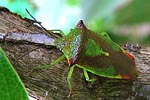 |
edaphic:
Horvathiolus
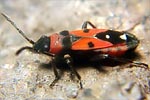 |
xylodetriticolous:
Aradus
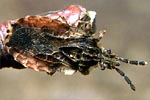 |

The pond skaters with very
large and, on the other hand, very minute forms, live on the water-surface
of pools, rivers and even the open sea. Microscopic hair structures at
their feet prevent them from sinking and allow a fast locomotion. Numerous
bugs have developed an aquatic way of live, keeping their flying ability.
Respiration takes place by catching air-bubbles from the water surface
(Corixidae, Notonectidae), respiration tubes (Nepidae) or by plastron respiration
(Aphelocheiridae), which allows the bugs to stay under water permanently.

pond
skater
Gerris
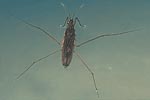 |
bachswimmer
Notonecta
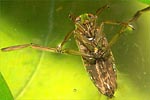 |
water scorpion Nepa
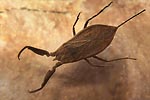 |
 |
 |
Nutrition
Bugs suck on plants (Tingidae,
Miridae, members of numerous other families), seeds (Lygaeidae) or feed
on insects (Anthocoridae, Nabidae, Reduviidae). Bed bugs (Cimicidae) feed
on the blood of birds and mammals (bats and humans, for example). Many
species are strictly bound to a single host plant (Tingidae) or specialised
on specific prey.

predators:Rhynocoris
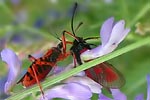 |
fruit
eating:Carpocoris
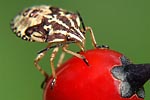 |
the
"Vampir" Cimex
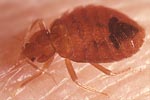 |
 |
 |
Reproduction
Most bugs show little differences
between males and females except their genital structures. Mating takes
place either abdomen versus abdomen, or the male climbing on the back of
the female after having injected the phallus in the vagina. Eggs are laid
in clusters, often in symmetrical formation. In the Acanthosomatidae females
watch their eggs and often the hatched nymphs, such practice is a form
of social behaviour.

a
couple of Graphosoma
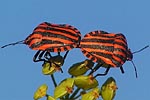 |
Elasmostethus
egglaying
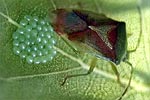 |
Elasmucha
guarding
eggs
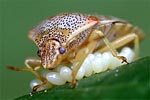 |
 |
 |
Nymph
Development
Bugs show an incomplete metamorphosis
from nymphal stages to imagines. That means, they don't have pupae like
beetles, butterflies, flies and wasps. The nyphal stages (mostly five)
are very similar to the adults, only missing complete wings and genital
structures. In most cases it is not possible to determine the nymphal stages
of bugs. Nymphs inhabit the same biotopes as the adults and feed on the
same plants and animal preys.

eggs
of
Chorosoma
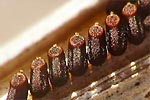 |
stadium
1 Pentatomidae
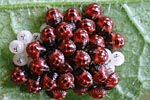 |
stadium
1+2 of Palomena
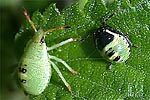 |

stadium
3 of Palomena
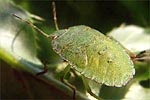 |
metamorphosis
to imago
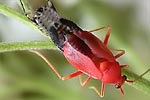 |
metamorphosis:
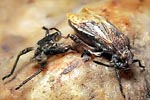 |
 |
 |
|

















